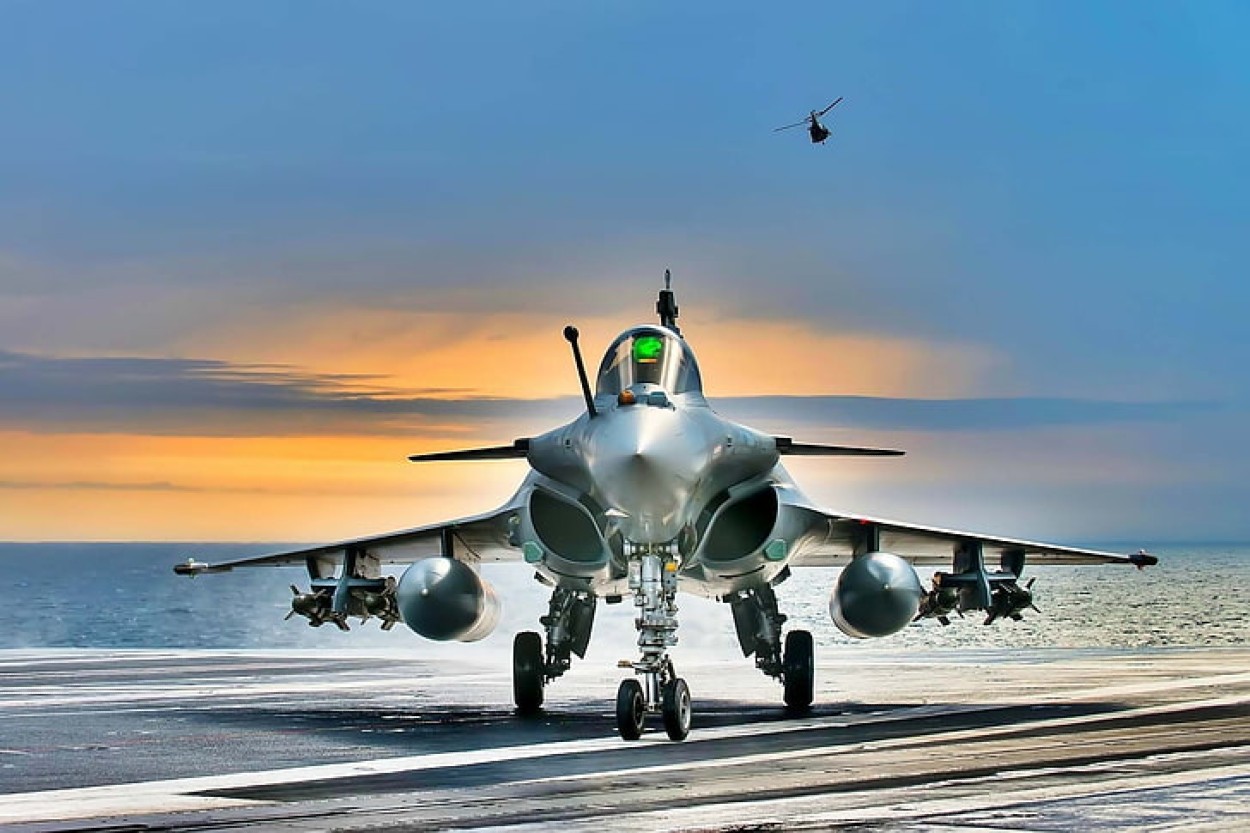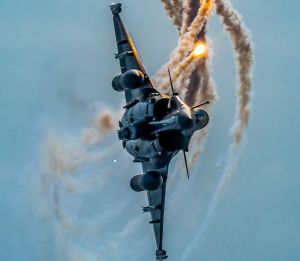France has received a Letter of Request (LoR) from India to sell Dassault Aviation’s Rafale Marine to the Indian Navy for its aircraft carriers. The deal for 26 Rafale-Ms reaching the finish line, the French aircraft maker is setting its eyes on the big ticket, an unfinished 114-jet order for the Indian Air Force.
The LoR is like a tender document in which the Indian government has specified all its requirements and capabilities on the Rafale Marine aircraft. It will operate from aircraft carriers — INS Vikrant and INS Vikramaditya.
The contract signing is still some time away, as France would still evaluate the LoR and reply to India with a Letter of Acceptance or LoA before cost negotiations for the 26 jets begin. The signing of the contract is expected in 2024.
Dassault Aviation has seen the demand increase for Rafale omni-role fighter jets globally after it delivered 36 Rafales for the IAF in a government-to-government contract. Most recently, the French media claimed that Rafale has won a deal to supply 54 Rafales to Saudi Arabia after a veto from Germany dashed the chances of Eurofighter Typhoon winning the contract.
Dassault Aviation’s Rafale is competing against Boeing’s F/A-18 and F/15EX, Lockheed Martin’s F-21, SAAB’s Gripen, and three other prominent combat jets from around the world for the Indian Air Force tender — called the mother of all deals — to supply 114 Multi-Role Fighter Aircraft (MRFA).
Rafale had, in 2013, won a previous tender for 126 jets, floated by the IAF in 2007, called the Medium Multi-Role Combat Aircraft (MMRCA) procurement program. But in 2015, Indian Prime Minister Narendra Modi canceled the tender, which had become unviable, and bought 36 Rafale off-the-shelf from France in a nearly US$8-billion deal. That’s why Dassault Aviation sees this MRFA for 114 jets as an “unfinished” business.
“IAF plans to induct six squadrons of MRFA in a phased manner. The program would be progressed under the ‘Make in India’ initiative of DAP-2020. Responses have been received for eight aircraft types,” IAF Air Chief Marshal VR Chaudhari told the Indian media. Experts, however, see the competition brewing between Dassault’s Rafale, Boeing’s F-15EX, and Saab’s JAS-39 Gripen.
“ASQRs (Air Staff Qualitative Requirements) have been finalized, and detailed interactions with OEMs (Original Equipment Manufacturers) have taken place. OEM commitments for indigenous content of selected categories and ‘Make in India’ provisions are being sought. Envisaged to integrate indigenously developed A-A (Air-to-air) and A-G (Air-to-ground) weapons on MRFA being manufactured in India,” the IAF chief added.
The IAF floated the RFI in 2018 and got an enthusiastic response from aircraft makers worldwide for the multi-billion-dollar deal. After setting the fresh ASQRs, as the EurAsian Times earlier reported, the IAF is awaiting the government’s nod to send a proposal for an Acceptance of Necessity (AoN). For a year, there has been no movement on the MRFA deal.
Air Marshal Narmdeshwar Tiwari, the former deputy chief of the IAF, had told journalists during Aero India 2023 (held in February) that the AoN is expected from the government in the next three to four months. It has been November, and the AON has not been granted yet to the IAF, which presently has 31 squadron strengths and stares at dwindling fighter squadron strength and an aging fleet.
The IAF needs many aircraft to be recognized as a deterrence to the People’s Liberation Army Air Force (PLAAF). “They (the IAF) have not been able to convince the Indian government that the imported aircraft are required in such large numbers. The whole process, up to aircraft delivery, will take 6 to 7 years. By then, Tejas Mk-2 may also be ready for induction. That may be the reason for the government’s indecision,” the official offered.
The IAF, toeing the Indian government’s ‘Make in India’ policy, has already expressed the intent to order 90 more Light Combat Aircraft Mk1.

Rafale Meeting IAF’s Urgent Requirement
The IAF’s requirement for the 114 MRFA is urgent to maintain a combative edge. Rafale has the advantage that the country’s air force is already operating the aircraft, and the navy will soon be inducting it.
The experts also see the advantage here, but the IAF officials don’t see it as a foregone conclusion as the ASQRs have been set afresh. The formulation of ASQR is the most crucial stage in defense acquisition as it determines the quality, price, and competition.
“The MMRCA competition was a thoroughly conducted process. It took us years to vet every contender. For MRFA, which is just a different name for the contract, I can only expect the ‘Make in India’ could be the deciding factor,” Air Marshal (Retd) M. Matheswaran, who had overseen the MMRCA tender for the IAF before retirement, told the EurAsian Times.
The IAF had proposed in August 2000 to acquire 126 Mirage 2000 II aircraft. The proposal was discarded in 2004, and in 2007, a decision was taken to buy 126 jets under MMRCA.

For Rafale, The Deal Remains
Rafale, a twin-engine multi-role aircraft, can carry out air-to-air combat or can drop bombs on targets in air-to-ground missions, and owing to its cameras, radars, and sensors, can be used for intelligence gathering.
The aircraft development took a long time. The demonstrator flew on July 4, 1986. The program was officially launched in January 1988, the prototype took to the air on May 19, 1991, and the first Rafale F1 was delivered to the French Navy precisely a decade later, on May 18, 2001.
Since then, France has deployed this combat jet in Afghanistan, Libya, Iraq, Syria, and Mali, where it flew its most extended mission in 2013, spanning nine hours and 35 minutes. Rafale’s stellar combat experience was documented in an earlier report of the EurAsian Times. From Afghanistan, Libya, Mali, Iraq & Syria, Rafale jets “outclassed” its enemies everywhere and have never-ever been shot down.
The aircraft manufacturer, Dassault Aviation, says that Rafale can carry out “the widest range of roles” with the smallest number of aircraft. It can carry long-range air-to-air Meteor, Beyond Visual Range air-to-air missile (BVRAAM) MICA, long-range standoff missile SCALP, anti-ship missile AM39 Exocet, Laser-guided bombs, and classic bombs.
The Rafale participates in permanent “Quick Reaction Alert” (QRA), air defense, air policing missions, nuclear deterrence duties, power projection and deployments for external missions, deep strike missions, air support for ground forces, reconnaissance missions, and pilot training sorties. It comes in three variants: single-seater Rafale C for the Air Force, twin-seater trainer for Air Force Rafale B, and single-seater for Navy Rafale M.
Rafale B and C entered service with the French Air Force in June 2006, when the first squadron was established. The company received the development contract for the Rafale F4 standard aircraft in January 2019. The validation of the latest standard is expected in 2024.
But to win the MRFA deal, the French aerospace major will have to go beyond this and offer to ‘Make in India,’ and what transfer of technology Dassault Aviation can offer remains to be seen. And there is no denying that with France’s fighter jet market saturated, India is a significant market.
- Ritu Sharma has been a journalist for over a decade, writing on defense, foreign affairs, and nuclear technology.
- She can be reached at ritu.sharma (at) mail.com
- Follow EurAsian Times on Google News




